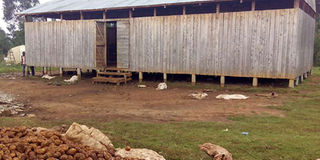Simple stores to keep potatoes

A potato store in Nyeri. Most farmers believe that they need a huge investment to build good potato storage facilities, however, there are simple stores built using minimal resources. PHOTO | JECINTA MWIRIGI | NMG
What you need to know:
- Improper storage facilities or lack of them has worsened the plight of farmers, with the perishability of the crop and its bulky nature making them more susceptible to low prices.
- Most farmers believe that they need a huge investment to build good storage facilities. Below are two simple potato stores that you can make on the farm and save yourself from the curse of brokers.
- To control rats, the posts are fitted with inverted metal cups at the house floor junction. The potato tuber moth can cause overwhelming damage to unprotected tubers.
- A study to establish the feasibility of low-cost seed potato storage in Kenya through use of DLS concluded that it is feasible to store seed tubers of currently available potato varieties under low-cost-on-farm conditions for up to eight months.
Over the years, potato marketing has become a painful experience for small-scale farmers due to low prices offered by traders.
Improper storage facilities or lack of them has worsened the plight of farmers, with the perishability of the crop and its bulky nature making them more susceptible to low prices.
The two qualities have enhanced the “farm to market” model of marketing potatoes, where they are harvested as transport facilities wait on the farm. Good storage facilities can enable farmers cure this menace.
Most farmers believe that they need a huge investment to build good storage facilities. Below are two simple potato stores that you can make on the farm and save yourself from the curse of brokers.
a) Wooden, raised-ware store
This is a non-electricity operated ambient (natural climatic conditions) structure that is made from locally sourced materials.
This structure not only makes marketing easy for individuals, but also for groups as transport to localised stores are avoided.
Further, when used by groups with individual structures, it makes management of the stores easier, affordable and traceability possible.
The issues to consider when putting up such a facility include the design, construction materials, pest management and costs.
The structures are either rectangular or square in shape, and they are made up of a raised timber floor, wooden walls and a corrugated iron sheet roof.
Depending on available resources, materials for the floor include 8 feet cedar posts, 4x2 inches and 6x1 inches timber and nails of assorted sizes.
The walls require 4x2 inches and 6x1 inches cypress timber, goose wire mesh and nails while the roof uses 4x2, 3x2 and 2x2 inches timber, GI sheets 30g and roofing and other nails. Other expenses are labour and transport.
Depending on the method used to store the produce, the inside of the store can be divided into two by a corridor and each side can further be sub-divided into cubicles with or without shelves.
This structure is meant to provide a conducive environment for ware potatoes that include free flow of air (ventilation), protection from pests and adverse temperatures and relative humidity.
To control rats, the posts are fitted with inverted metal cups at the house floor junction. The potato tuber moth can cause overwhelming damage to unprotected tubers.
Good agricultural practices like the control of the pest in the field and planting certified seeds produces healthy tuber for storage.
Potatoes can remain in good shape for 2-3 months in the store. At the storage time, the store should be clean and loading should take into consideration the order in which the product will be offloaded with enough space left for mobility of personnel and offloading activities.
The inside and outside temperatures and the relative humidity should be monitored regularly. Presence of pests should be counteracted at the earliest time possible and good records should be kept.
When using bags, do not stack more than two but up to 10 crates of 100kg can be arranged. Bags are for a short storage.
A group in Nyandarua put up a 13.8m by 6.1m structure at Sh490,000. This facility enables the group to sell a 100kg bag of potato at Sh4,000 instead of Sh1,800 during the surplus period.
b) Diffuse light store (DSL)
This store is similar in design and construction to the wooden ware potato store. The main difference is the spacing of the wall and floor timber, which leaves a bigger space for ventilation and light.
Light is important in promotion of well-sprouted seed necessary for early crop establishment and thus higher yields.
Due to the timber spacing, the structure requires aphid proof-netting.
A study to establish the feasibility of low-cost seed potato storage in Kenya through use of DLS concluded that it is feasible to store seed tubers of currently available potato varieties under low-cost-on-farm conditions for up to eight months.
DLS does not apply to short dormancy varieties like Shangi.
Dr Mwirigi, [email protected]




